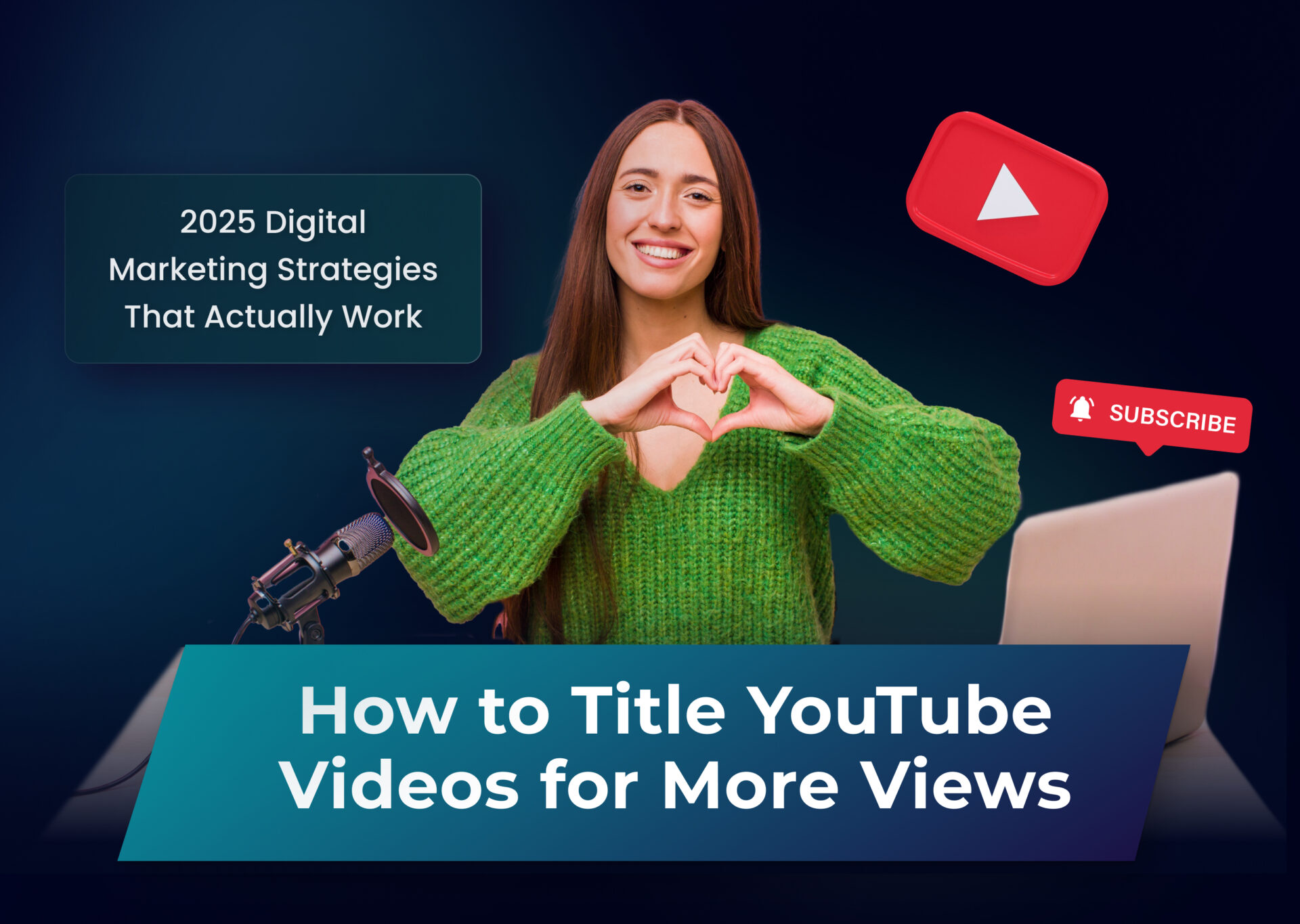How to Title YouTube Videos for More Views: Full Guide

Let’s face it – you could create the most amazing YouTube video, but without a good title, it might never reach its intended audience. Today’s YouTube, with over 500 hours of content uploaded every minute, gives creators no room for error. Standing out from the competition isn’t just about quality content – it’s about knowing how to write exciting YouTube titles that grab attention and drive clicks. Whether you’re a seasoned content creator or just starting your YouTube journey, understanding how to craft magnetic titles can be the difference between your video getting lost in the void or reaching thousands of potential viewers.
Ready to transform your YouTube presence? In this comprehensive guide, we’ll dive deep into proven strategies for creating titles that not only attract viewers but also work with YouTube’s algorithm. Keep reading to discover the secrets behind titles that don’t just get views but also build audiences.
Table of Contents
Why Is a Good YouTube Video Title Important?
Before YouTube users even get started with your content, all they know about it is what you tell them in the title. Your video’s title is your first and sometimes only chance to convince viewers that your content is worth their time. Think of it as the digital equivalent of a book cover or a movie poster, serving as both a preview and a promise of what’s to come. Here are a few reasons you need strong YouTube video titles for your content.
Positive Impact on Click-Through Rates
Click-through rate (CTR) is the percentage of people who click on your video after seeing it in their feed, search results, or recommendations. A well-crafted title can dramatically improve your CTR. The key is finding the sweet spot between being descriptive and intriguing without overdoing the clickbait – you want to give viewers enough information to understand what your video is about while maintaining an element of curiosity that compels them to click.
For example, a basic title like “How to Make Pasta” might get lost in the sea of similar videos. However, “5 Pasta Cooking Secrets Chefs Never Tell You” creates intrigue while still clearly communicating the video’s value to potential viewers.
Navigating YouTube’s Algorithm
YouTube’s search algorithm uses your title as one of the primary signals to understand your content and decide who to show it to. The algorithm analyzes video titles to:
- Match your video with relevant search queries
- Identify the main topic and themes
- Determine which viewers might be interested in your content
- Compare your video to similar content in the same category
When your title accurately reflects your content and includes relevant target keywords naturally, you’re helping YouTube connect your video with the right audience. This alignment between title, content, and viewer interest can trigger the algorithm to suggest your video more frequently in recommendations.
Influence on Viewer Perception
Your title sets immediate expectations and shapes how viewers perceive your content before they even click play. A professional, well-thought-out title suggests quality content, while a poorly written or misleading one can damage your channel’s credibility.
This first impression affects not only whether someone clicks on your video but also how they engage with it once they’re watching it. When your title creates accurate expectations, viewers are more likely to watch your video for longer periods, engage with likes and comments, subscribe to and share your content, or even return for more videos.
Remember that building trust with your audience starts with your video titles. While it might be tempting to use clickbait tactics for short-term gains, maintaining honesty and accuracy when you write titles helps build a loyal audience that values your content and returns for more.
Key Elements of an Effective YouTube Video Title
Creating YouTube video titles that attract views is based on understanding the essential components that make viewers click. The most successful YouTube creators have mastered the art of balancing several key elements in their titles to maximize appeal while accurately representing their content. Let’s check them out and see how they write titles that convert viewers into subscribers.
Clear Value Proposition
A good video title should quickly communicate the value viewers will gain from watching your video and subscribing to your YouTube channel. This could be entertainment, education, inspiration, or problem-solving. Ask yourself, “What will viewers gain in exchange for their time?” Then, make sure that the benefit is front and center in your title.
Examples:
- “How to Fix a Slow Computer in Under 10 Minutes”
- “3 Exercises That Eliminate Lower Back Pain”
- “The Truth About Intermittent Fasting: What Science Actually Says”
Strategic Keyword Placement
Including relevant keywords in your video titles isn’t just for search engine optimization – it helps viewers instantly recognize that your content matches what they’re looking for. Our experience shows that placing your primary keyword near the beginning of your title can improve click-through rates, as it immediately signals relevance to both the algorithm and potential viewers.
Examples:
- “iPhone Photography: 7 Pro Tips for Amazing Shots”
- “Sourdough Bread Recipe That Never Fails”
- “JavaScript Tutorial for Absolute Beginners”
Emotional Triggers
Titles that evoke emotion tend to perform better than purely informational ones. Consider incorporating words that trigger curiosity, excitement, urgency, or other relevant emotions into your content. These emotional hooks create a compelling reason to click beyond the informational value.
Examples:
- “The Shocking Truth About Popular Skincare Ingredients”
- “I Tried the Viral TikTok Hack and Was Stunned by the Results”
- “Never Make These Embarrassing Grammar Mistakes Again”
Numbers and Specificity
Including numbers in your YouTube video titles makes them more scannable and communicates concrete value. Numbers also signal organization and clarity – this way viewers know exactly what to expect. Being specific makes your video titles more believable and actionable.
Examples:
- “7 Quick Dinner Recipes Ready in 15 Minutes”
- “Build a $500 Gaming PC That Runs Any Game”
- “30-Day Yoga Challenge: Transform Your Body and Mind”
Length Optimization
While the YouTube title character limit is up to 100 characters, research suggests that titles between 40-60 characters perform best. This length is short enough to be fully displayed in search results and recommendations while providing enough space to include your keywords and value proposition. On mobile devices, even shorter titles (around 40 characters) ensure nothing important gets cut off.
Timeliness and Relevance
Including references to current trends, seasons, events, or challenges can significantly boost your title’s appeal. Viewers are naturally drawn to content that feels fresh and connected to what’s happening now.
Examples:
- “2025 Digital Marketing Strategies That Actually Work”
- “Summer Capsule Wardrobe: 10 Pieces, 30 Outfits”
- “Reacting to the New Apple Launch: Worth the Hype?”
Remember that the best YouTube video titles combine several of these elements naturally while remaining truthful about the content. Your goal is to create a title that stands out in a crowded feed while accurately representing what viewers will experience when they click.
The Power of AI in YouTube Title Generation
The landscape of content creation is evolving rapidly, and artificial intelligence is becoming an invaluable ally for YouTube creators. AI-powered title generators analyze vast amounts of data from successful videos to identify patterns in high-performing titles across different niches. Unlike manual methods that rely on intuition or limited testing, AI can process information from thousands of videos to determine what truly drives clicks and engagement in your specific content category.
These tools go beyond simple keyword suggestions by understanding context, emotional triggers, and even the subtle linguistic nuances that make titles more appealing to human viewers. The result is video titles that are not only optimized for the algorithm but crafted to resonate with your target audience.
Try Dubs’ AI YouTube Title Generator
If you’re ready to use AI to grow your channel, Dubs’ AI YouTube Video Title Generator offers an excellent starting point. This specialized tool combines cutting-edge natural language processing with YouTube-specific optimization to generate titles that attract both the algorithm and real viewers.
Dubs is specifically trained on YouTube data and understands the unique requirements of video titles that perform well on the platform. The free tool allows you to input your video topic and key points and then produces multiple title options tailored to your content and niche. The best part of it is that you maintain creative control – the AI generates suggestions that you can use as-is, modify to match your style, or use as inspiration for your own creation.
Whether you’re just starting your YouTube journey or looking to boost the performance of your established channel, experimenting with Dubs’ AI title generator could give you the competitive edge you need in today’s crowded content landscape. Try it for free, and watch your YouTube videos shine.
Common Mistakes to Avoid When Crafting YouTube Video Titles
Even experienced content creators can fall into traps that can ruin seemingly good video titles. Being aware of these common pitfalls will help you craft titles that truly perform rather than ones that sabotage your success before viewers even have a chance to engage with your content.
Misleading Clickbait
While it might be tempting to exaggerate or make sensational claims to boost initial clicks, misleading clickbait damages your channel in multiple ways. When viewers feel tricked into clicking, they typically leave quickly (increasing your bounce rate), avoid liking or commenting, and become hesitant to click on your future videos. YouTube notices these negative engagement signals and will reduce your video’s reach as a result.
Example to avoid: “I Found a $1,000,000 Treasure!” (when in reality you found an interesting rock at the beach)
Keyword Stuffing
Cramming too many keywords into your title looks unprofessional and can trigger YouTube’s search engine spam filters. Modern SEO rewards natural language that prioritizes user experience over mechanical keyword insertion. Even an optimized title should read naturally to humans first, with keywords integrated thoughtfully.
Example to avoid: “Car Repair Auto Fix DIY Mechanic Engine Repair Tutorial How To Fix Car Problems”
Being Too Vague
Generic titles fail to communicate specific value and don’t stand out in search results or recommendations. Vague titles like “My Day” or “Gaming Video” give viewers no compelling reason to click and make it nearly impossible for YouTube to categorize your content properly.
Example to avoid: “Makeup Tutorial” (Instead, specify what makes your tutorial unique or valuable)
Front-Loading Brand Names
Starting your title with your channel name or brand wastes prime title real estate. Most viewers decide whether to click within seconds, so leading with what matters to them – not your brand– is crucial. Save your branding for your thumbnail or YouTube channel name, or place it at the end of your title if needed.
Example to avoid: “TechChannel | I Reviewed a Smartphone” (Better: “iPhone 15 Review: The Surprising Features No One’s Talking About | TechChannel”)
Ignoring Mobile Viewers
Over 70% of YouTube watch time comes from mobile devices, where titles are often truncated after 35-40 characters. Placing critical information too far into your title means many viewers will never see it. Always structure your titles so the most important information appears first.
Using ALL CAPS Excessively
While capitalizing a word or two for emphasis can be effective, titles written entirely in capital letters appear spammy and unprofessional. YouTube viewers have become increasingly sophisticated and tend to avoid content that looks like it’s shouting at them.
Example to avoid: “INSANE WORKOUT THAT WILL CHANGE YOUR LIFE FOREVER!!!”
Neglecting Search Intent
Creating titles without considering what viewers are searching for leads to low visibility. Take time to understand whether people searching your keywords have informational, navigational, or transactional intent, and align your title accordingly.
Example: If people searching “keto diet” are primarily looking for beginner information, a title like “Advanced Keto Macronutrient Calculations” might get low clicks despite being well-crafted.
Following Outdated Trends
Title formats that worked well in 2018 or even 2023 may not perform the same way today. Viewers develop “trend blindness” to overused title structures, and the algorithm continually evolves. Stay current by regularly analyzing what’s working now rather than relying on past formulas.
By avoiding these common mistakes, you’ll create titles that not only attract more views but also build trust with your audience and align with YouTube’s best practices for long-term channel growth.
Measuring the Success of Your YouTube Titles
Creating an effective YouTube title is just the beginning of an ongoing optimization process. Understanding how to measure your YouTube video performance helps you refine your approach over time and develop a data-driven title strategy that consistently delivers results.
Key Metrics to Track
Click-Through Rate (CTR)
The single most direct measurement of your title’s effectiveness is click-through rate – the percentage of people who click on your video after seeing it in their feed, search results, or recommendations.
The average YouTube CTR falls between 2-10%, with 4-5% considered healthy for most established channels. However, you should remember that CTR varies significantly by niche, so compare your videos against each other rather than against channels in different categories.
A low CTR with good impressions suggests your title and thumbnail combination isn’t compelling enough for your target audience, while a high CTR indicates you’ve found a winning formula worth analyzing and repeating.
Impressions
Impressions tell you how many times your video thumbnail was shown to potential viewers across YouTube. This metric helps you understand if the algorithm is pushing your content based partly on how it interprets your title.
Pro tip: Compare impressions across similar videos to identify which title styles earn more algorithm exposure.
Average View Duration and Retention
While not directly related to your title, these metrics help identify if your title is setting proper expectations for your content.
If viewers click but leave quickly, your title might be misleading or overpromising. Look for sharp drop-offs in the first 30 seconds, which often indicate a mismatch between viewer expectations set by your title and the actual content.
Search Traffic Percentage
This metric reveals how effectively your title is working for SEO purposes. A high percentage of search traffic confirms your title contains keywords people are actively searching for. Videos with strong search traffic tend to have longer lifespans than those depending primarily on recommendation traffic.
Community Feedback
Last but not least, direct feedback from viewers can provide qualitative data that metrics alone might miss. Look for comments mentioning the title (“I clicked because…”) to get insights directly. Don’t ignore negative comments if you get any – they provide information too. For more depth, try asking your viewers directly about what attracted them, or do community post polls asking which potential title would be more clickable.
Conclusion: The Art & Science of Writing YouTube Video Titles That Convert
Crafting the perfect YouTube title is both an art and a science. As we’ve explored throughout this guide, effective titles communicate clear value, incorporate strategic keywords, evoke emotion, and align with viewer search intent.
Remember that no single formula guarantees success. The most effective approach is one of continuous experimentation and measurement. Track your CTR, impressions, and viewer behavior to understand what resonates with your specific audience. Learn from your high-performing titles and adapt those insights to future content.
Whether you’re leveraging AI tools like Dubs’ title generator or refining your manual approach, focus on creating compelling titles that engage without being misleading. Your title is a promise to viewers, so make it accurate, make it intriguing, and deliver on that promise with your content.
More articles

150+ Best Vacation Instagram Captions to Make Your Travel Photos Pop
Planning your dream vacation is exciting, but finding the perfect words to accompany those stunning photos can be challenging. Whether you’re lounging on a tropical beach, exploring ancient ruins, or hiking breathtaking mountains, the right caption can elevate your Instagram post from ordinary to unforgettable. You’ve packed your bags for the family vacation, created memories, […]

175+ Unforgettable Prom Instagram Captions to Make Your Night Shine | 2025 Edition
Capturing the magic of prom night on Instagram requires more than just stunning photos – you need the perfect caption to complete your post. Whether you’re looking for something sentimental, funny, referencing your favorite song lyrics, or the photos from the dance floor, the right words can make your prom memories shine even brighter on […]

200+ Beach Instagram Captions: From Funny to Inspirational Quotes
Looking for the perfect words to pair with your beach photos? You’re not alone. A day at the shore isn’t truly complete until you’ve captured those sun-soaked moments and shared them with a caption that perfectly complements your vibe. Whether you’re posting golden hour selfies, documenting beach games, or showcasing those “sunkissed nose, sandy toes” […]